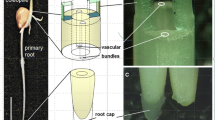Abstract.
Data and theories about the identity of the mass that acts in gravitropic sensing are reviewed. Gravity sensing may have evolved several times in plants and algae in processes such as gravitropism of organs and tip-growing cells, gravimorphism, gravitaxis, and the regulation of cytoplasmic streaming in internodal cells of Chara. In the latter and in gravitaxis, the mass of the entire cell may function in sensing. But gravitropic sensing appears to rely upon the mass of amyloplasts that sediment since (i) the location of cells with sedimentation is highly regulated, (ii) such cells contain other morphological specializations favoring sedimentation, (iii) sedimentation always correlates with gravitropic competence in wild-type plants, (iv) magnetophoretic movement of rootcap amyloplasts mimics gravitropism, and (v) starchless and intermediate starch mutants show reduced gravitropic sensitivity. The simplest interpretation of these data is that gravitropic sensing is plastid-based.
Similar content being viewed by others
Author information
Authors and Affiliations
Additional information
Received: 27 June 1996?/?Accepted: 3 December 1996
Rights and permissions
About this article
Cite this article
Sack, F. Plastids and gravitropic sensing. Planta 203 (Suppl 1), S63–S68 (1997). https://doi.org/10.1007/PL00008116
Issue Date:
DOI: https://doi.org/10.1007/PL00008116




